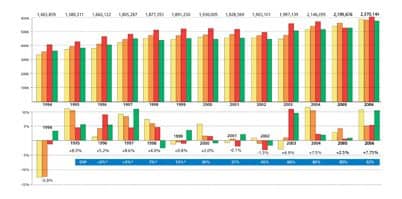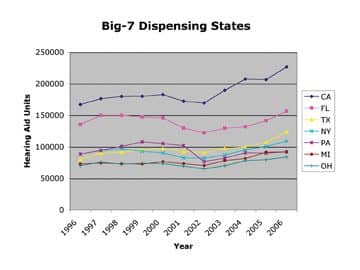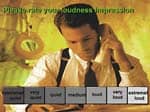There is a hot renewal of interest in the successful same-day fitting scenario, although it is hardly a new concept. Ironically, the first stock earmolds were introduced in 19221. The quest for same-day fitting springs from the inconvenience of having to take a custom impression of the ear, the delay between the decision to pursue amplification and the actual fitting—caused by the [desire for] customized fabrication of an earmold or an in-the-ear (ITE) instrument—the unpleasant sensation experienced by the potential hearing instrument wearer during the ear impression, and the uncertainty of how successful the custom-fit earmold or hearing instrument will, in fact, fit.
One of the fundamentals of successful hearing instrument fittings has been (surprise!) the fit. More to the point, it has been the coupling of the hearing instrument to the wearer’s ear so that the amplified/processed signal can be efficiently delivered to the hearing system. Efficient delivery demands that the coupling is true to the contours and configurations of the individual’s outer ear and ear canal architecture, provides a comfortable fit in all daily situations, and provides a secure acoustic seal to eliminate, or at least minimize, uncontrolled leakage of signal from around the hearing instrument or earmold and out of the ear.
EAR IMPRESSIONS: ONE SHAPE FOR A DYNAMIC EAR?

|
| Ed Desporte |
The primary method of achieving a custom fit has been through the use of ear impressions. The first US patent for a custom earmold was granted in 1926, and assigned to Western Electric Co1. From the beginning, these custom earmolds were produced by dental laboratories; small wonder, since similar materials were used in ear and dental impressions, and similar materials were used for denture subassemblies and earmolds.
Aside from discomfort and delays, the custom ear impression has one overwhelming flaw: It is a static “snapshot” of the ear canal. At its very best, it represents that ear canal in one condition only. This flaw exists regardless of whether that condition is “mouth open” or “mouth closed.”
In truth, the human ear canal is dynamic in nature, in large part due to the motion of the temporomandibular joint (TMJ). That dynamic action along the anterior-posterior plane of the ear canal varies by 3 to 5 mm with talking and chewing. The degree of TMJ action not only varies from individual to individual, but research has shown that it varies significantly from one individual’s ear to the other2. Complicating the attempt to fit a statically designed instrument into a dynamic environment was the fact that almost all custom-fit hearing instruments have been constructed of rigid acrylic.

|
| Roger Juneau |
THE EVOLUTION OF SAME-DAY FITTING DEVICES
Hearing instruments constructed of soft materials had been attempted in the past, and had been perceived by many as preferable to acrylic shells based on comfort, adaptability to changes in the ear canal, and better sound quality. Most attempts were not successful because they used thermoplastic elastomers that were prone to shrinkage, hardening, and cracking over time. Most mimicked traditional shell technology in that they were hollow and tended to bend upon insertion.
In the late 1990s, a method of bonding silicone to an acrylic faceplate was patented3. Uniquely, the method employed very low durometer silicone, and the electronic components were completely embedded in the silicone with no interior spaces. Utilization of that technology did overcome many of the previous shortcomings. Nevertheless, when utilized in the custom-fit format, these soft instruments were subjected to the same shortcomings of custom ear impressions as their acrylic counterparts.
While there have been a number of approaches to achieve same-day fittings, most have been variations of the standard model of earmold/hearing instrument manufacturing.
For behind-the-ear (BTE) hearing aids, “instant” earmolds utilizing acrylic technology date back to 19574. Produced at the dispenser’s office, their primary purpose was to eliminate the delay, although high-fidelity representation of the ear canal was also a goal.
Same-day fitting for ITE hearing aids has generally followed one of two scenarios:
- Faceplates provided by a manufacturer with an earmold/hearing aid lab on site;
- Manufactured, noncustom, acrylic instruments designed to fit the mythical “standard” ear.
Few of these attempts have been successful.
In the first scenario, the focus was to duplicate—on a smaller scale—traditional custom hearing instrument manufacturing. This required significant investment: special licensing, equipment, dedicated lab space, and talented, well-trained personnel.
The second scenario—besides being dependent upon the concept of an “average” ear canal—utilized instruments manufactured with acrylic shells. In most cases, these instruments failed because they did not provide the acoustic seal necessary for acceptable and useful gain before feedback, or proved to be uncomfortable because of their hard, unyielding construction. Because of the rigid nature of acrylic shells, attempts to address these acoustic seal failures and comfort issues were limited to exterior modifications:
- Acrylic add-on material could be applied to the shell surface:
- These coatings often appeared rough and unfinished.
- More importantly, the application of these materials was almost always imprecise, often resulting in discomfort or undesirable acoustic side effects.
- Foam could be applied to the receiver tip or at the aperture area:
- Multiple sizes were needed to achieve a fit.
- They were hard to insert.
- They were uncomfortable and stuffy.
- They cannot be reused and must often be replaced as cellular foam quickly becomes soiled.
- It looks unfinished or temporary.
An obvious alternative to acrylic instruments in this same-day scenario is the use of instruments constructed of soft material. These have been very well accepted from a comfort stance, but share the shortcoming of being incapable of adapting to varying ear topography. As a result, many fittings were compromised by the implementation of dated, low-power analog technology.
Unlike rigid acrylic instruments, however, the soft format provides the possibility of alternative methods to adapt a noncustom fit to accommodate an individual’s ear canal. Instead of relying on exterior “add-ons,” the soft format made interior adjustments possible. A number of solutions have been attempted:
- Fixed-force spacers (springs, plastic rings)
- Different sizes are required.
- Placement of the spacer is inexact.
- Fixed force applied by the spacer cannot be changed.
- Bladder technology
- A complicated clinical procedure is required to interface pressurizing medium to the bladder(s).
- Pressurizing the bladder(s) with the instrument in the ear may lack control to deliver desired comfort.
- Once sealed, the pressure inside the bladder(s) may not be variable, and may not provide consistent comfort throughout the day.
- It is not consistently manufacturable.
THE BIOSCIENCE BEHIND STENT TECHNOLOGY
A solution that could overcome the inexactness and unvarying pressures of the previously mentioned strategies was found outside the hearing industry: “Memory metal,” specifically Nitinol, which is most commonly associated with the manufacture of coronary stents.
Of the many mechanical properties unique to Nitinol, the most important is superelasticity: the transformation from rigidity (the Austenitic phase, Figure 1 below, left) to malleability (the Martensitic phase, Figure 2 below, right) upon cooling, and the reverse transformation from Martensitic to Austenitic upon heating. Two critical characteristics exhibited in the Austenitic phase are the loading plateau and the unloading plateau, usually diagrammed on a stress strain curve. The loading plateau is the stress level at which material at a specific temperature above the Austenite finish temperature, Af, will force the Austenite phase into Martensite. This produces an almost constant stress level over a relatively large range of strain (up to about 8%). This means that the stent moves until it meets a specific resistance, not a fixed distance. Therefore, a 5-mm expansion range delivers the same wall pressure to a small ear canal as it does to its larger counterpart, the heart.

|
| These figures show the superelasticity of memory metal during the Austenitic and Martensitic phases. |
STENTED TECHNOLOGY:
- Can be calibrated to activate in response to a specific temperature (eg, ear canal temperature).
- Can be calibrated and polished (to nearest 100th of a Newton), resulting in precise interfacial pressure between the ear canal and the soft hearing instrument body.
- Provides excellent biocompatibility. Stents emerged from coronary implant surgery.
- The constant stress level provides for dynamic reaction to changes in the ear canal.
- Enables the use of state-of-the-art signal processing in same-day fitting scenarios.
A NEW PATH
Stented technology offers more than simply improving the fit of same-day fittings. It offers a method to overcome the shortcomings of the hearing instrument or the earmold manufactured on the basis of a static (though custom) ear impression. It brings to reality the scenario of taking a noncustom instrument off the shelf, placing it in the wearer’s ear, having the embedded stent sense body temperature, and having the stent expand to seek out the unique configuration of the wearer’s ear canal.
With the vagaries of fit issues removed, the clinician can focus on meeting the electroacoustical needs of the patient. In fact, stent technology leads us past the narrow realm of hearing instrument fittings to the concept of the self-forming listening system, opening the road to recreational, industrial, and personal communication applications.
REFERENCES
- Berger K: The Hearing Aid: Its Operation and Development. 3rd ed. Michigan: National Hearing Aid Society; 1984: 163.
- Oliveira R: The dynamic ear canal. In: Balanchanda BB, ed. The Human Ear Canal. San Diego: Singular Publishing Group; 1995:86-91.
- Creel LP, Desporte EJ, Juneau RP. Soft-solid instruments: a positive solution to the dynamic ear canal. Hearing Review, 1999, 3:40-43.
- Berger K: The Hearing Aid: Its Operation and Development. 3rd ed. Michigan: National Hearing Aid Society; 1984:176.
Ed Desporte, MS, is director of product development and quality assurance at General Hearing Instruments Inc, New Orleans, and coinventor of several hearing industry–related patents. He can be reached at . Roger Juneau is president of General Hearing Instruments, and author of several US and international patents.





